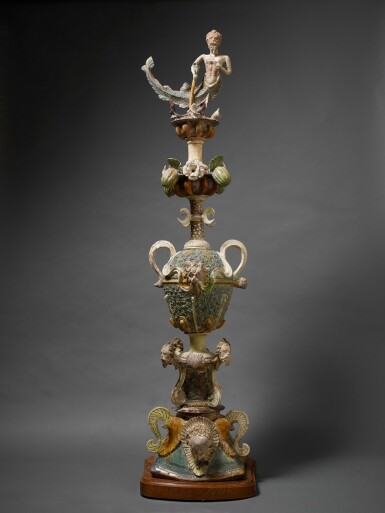Refining Taste: Works Selected by Danny Katz
Refining Taste: Works Selected by Danny Katz

PRÉ D'AUGE, FRANCE | ROOF FINIAL
Lot Closed
May 27, 03:28 PM GMT
Estimate
3,000 - 5,000 GBP
Lot Details
Description
PRÉ D'AUGE, FRANCE
early 17th century
ROOF FINIAL
glazed ceramic, with a wood base
height: 142cm., 55⅞in.
To view shipping calculator, please click here.
Galerie Theorème, Paris, 2016
These elaborate roof finials or épis-de-faîtages are thought to have been made in the Pré d’Auge or possibly at Manerbe near Lisieux in the Calvados region of Normandy. They are an amalgamation of Italian and French inspiration, Medieval and Renaissance technique with some local accents which conspire to create a distinctive element to the Normandy skyline.
The overall composition owes something to the Italian Renaissance as seen in the elongated decorative panels of grotteschi engraved by Giovanni Pietro da Birago and Giovanni Antonio da Brescia and later the designs of Etienne Delaune. Their fabrication demonstrates an evolution of the encaustic work of local tile makers and the more refined faience of Saint-Prochaire and undoubtedly the influence of the “grottier et architecte des rustiques figulines du roy et de la royne”, Bernard Palissy and his followers.
Early roof finials could be formed as models of birds or figures covered in simple glazes but became more ambitious, being composed of several elements designed to fit together on a metal pole with increasingly complex ornament. In the case of the present example the design is centred with an ovoid vase supported by a pyramidal base applied with a winged mask issuing from a ruff and a socle applied with bearded masks and shell ornament; both parts are further embellished with flattened scroll handles. The ovoid body of the vase section is moulded with two lion's masks, loop handles and ribbons above gadrooning. A textured ground imitating foliage on rockwork is in the style of Palissy and a narrow columnar neck projects four crescents. The mouth of the vase supports a gadrooned bowl applied with small melons and blossom, a local speciality, and above, rising from a second gadrooned bowl is a triton and anchor.
Pré d’Auge and Manerbe were the centers for the production of ceramics in Normandy. Along with paving tiles, the manufacture of roof finials was a particularly important characteristic of the region from the late 15th to the 17th century. Ornate and brightly coloured, these were used to adorn the grand buildings and manors of the region and they were also prized at the courts of Henri IV and Louis XIII. Whilst they had fallen out of favour by the end of the 17th century, production continued into the 18th century before finally ceasing by the end of the century.
A number of articles in the 19th century saw an increase in interest from collectors in these early architectural gems and their popularity led to a revival in production. In the early 20th century, the definitive work was produced by Étienne Deville who lists numerous examples in French museums, private collections as well as those intact at the time of publication. The author illustrates an example from the Château d’Ouilly-le-Vicomte, see Deville, E., Le céramique du pays d’Auge: l’art de terre à Manerbe et au Pré-d’Auge, Paris, 1927, pl. VIII, 3 and no. 1 for another with similar crescent-shaped projections to the present finial. A finial which has a similar base with winged masks, columnar support, ovoid vase-form section and fruit and flower encrustations is in the collection of the State Hermitage Museum, St. Petersburg (inv Φ-2611) having entered the collection in 1925 from the Shuvalov Palace which housed the Museum of Aristocratic Life after nationalisation following the Russian Revolution. A finial in the form of a mermaid with comb and glass which is very close the top section of the present finial is in the collection of the Victoria & Albert Museum, London (inv. 655:1-1906).
